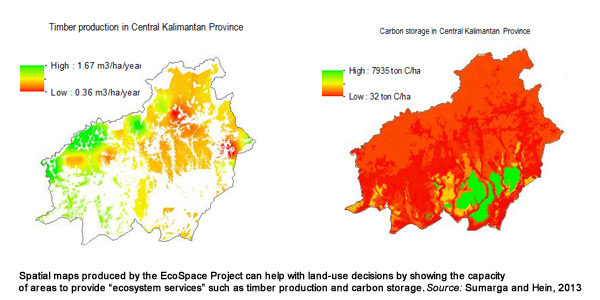
Ecosystem accounts show how the services provided by an entire ecosystem feed into economic activity, and can provide a useful and important tool for land-use planning. Preliminary results from the EcoSpace project were recently shared with the WAVES Policy and Technical Experts Committee.
Central Kalimantan, located on the Indonesian part of the island of Borneo, is covered with lush lowland rainforests in the center of the region, and peat swamp forests in the south that are home to the world’s largest orangutan population. As peat swamp forests have been converted to palm oil production—which plays a significant role in the livelihoods of locals and in Indonesia’s overall economic development—the area has fallen threat to logging, peat drainage and fire, all contributors to increased carbon emissions.
Central Kalimantan is one of four case studies where the EcoSpace project is producing spatial maps and biophysical modeling as part of constructing “ecosystem accounts”— the most comprehensive of all types of natural capital accounts that incorporate a broad collection of data to measure services provided by an entire ecosystem, such as food and drinking water production, carbon sequestration, water purification and recreational use. The methodology to do ecosystem accounts is still experimental but through projects like these, experts are hoping to standardize it over time.
Maps can provide physical and monetary assessments of natural assets
The tools being developed by the EcoSpace project can help decision makers make tough land-use decisions, such as how to identify areas to expand the palm oil sector that won’t disturb the orangutan habitat, decrease land for tourism, or increase deforestation.
 “A big advantage of ecosystem accounting is that you can monitor the sustainability of natural capital and also understand how your natural capital is feeding into economic activity.”
“A big advantage of ecosystem accounting is that you can monitor the sustainability of natural capital and also understand how your natural capital is feeding into economic activity.”
Lars Hein, Associate Professor, Wageningen University and Leader of the Ecospace Project
The maps will also help show which areas have the greatest potential for carbon storage, an important issue considering Indonesia has a voluntary carbon emissions reduction target of 26% by 2020 and forests play a crucial role in carbon storage or “sequestration.” Central Kalimantan was chosen to lead Indonesia’s trials of the UN-backed Reducing Emissions from Deforestation and forest Degradation (REDD+) program, through which Indonesia can receive funds under a partnership with the Norwegian Government for reducing deforestation and forest degradation.
The project is funded by the European Research Council and is also being implemented in Benin (Upper Ouémé catchment funded by AfricaRice), the Netherlands (Limburg Province), and with the Norwegian partner ‘NINA’, in Norway (Telemark Fylke).
For each site, eight to nine ecosystem services were chosen based on input from stakeholders, and four papers will be produced for ecosystem services and ecosystem assets showing the physical, monetary, and policy applications of the results. Four PhD students assist with the work and in Central Kalimantan researchers from the local University of Palangka Raya collaborate on the project, among others.
“A big advantage of ecosystem accounting is that you can monitor the sustainability of natural capital and also understand how your natural capital is feeding into economic activity,” said Lars Hein, leader of the Ecospace project and an associate professor at Wageningen University. “Because of the spatial approach it can also be used for land-use planning, which is important in developing countries because land use is often changing very fast.”
Government officials and other stakeholders in Central Kalimantan were presented with physical maps in early 2013 that show indicators for orangutan habitat, carbon storage, land used for recreation, for the production of palm oil, timber, rattan and rice. They expressed great interest in the information and can use it as an input in spatial planning.
In vivid layers, Ecospace spatial maps show “provisioning services”—the capacity of a natural asset to provide products and the amount of products extracted or harvested, such as how much timber can be sustainably provided by a forest; as well “regulating services” that show the regulating impact of ecosystems, such as how forests also play a role in watershed and erosion management.
They are produced using data from different sources: spatial, sensing, satellite, and data generated by the project. Hein said countries could generate data using basic GIS software that is already often used by government planning agencies.
With the physical maps completed for all three sites, the project is now working on inputting data to produce the monetary maps by assigning monetary values in a way that is consistent with a country’s national accounts.
Ecospace is one of three ecosystem accounting methodologies piloted by WAVES experts committee
Preliminary results from the project were recently shared with the WAVES Policy and Technical Experts Committee (PTEC) at their second annual meeting November 6-8, 2013, in Washington, DC.
PTEC is composed of nearly 30 experts in environmental accounting that include economists, natural scientists and policy experts from the World Bank, UNEP and other UN agencies, as well as from academic institutions and government. The committee was established in the fall of 2012 to provide guidance and support for one of three objectives of the WAVES partnership: develop internationally-agreed guidelines for ecosystem accounting.
EcoSpace is one of three different methodologies for ecosystem accounting the PTEC Committee is piloting and testing to determine what methodologies work under what circumstances. The results of the pilots will be reported back to the United Nations Statistical Commission as input to the process aimed at testing implementation of the handbook for the System of Environmental and Economic Accounts (SEEA), Vol. 2 on Ecosystem Accounting.
Other pilot projects chosen by the WAVES PTEC Committee are taking place in San Martin, Peru led by Conservation International (CI) under the Ecosystem Values Assessment and Accounting (EVA) and in Himachal Pradesh, India being led by PTEC to help test InVEST (Integrated Valuation of Environmental Services and Tradeoffs) and SWAT (Soil and Water Assessment Tool) models.
Core WAVES countries interested in undertaking ecosystem accounts include the Philippines (in Southern Palawan and Lake Laguna); Colombia (watersheds); and Madagascar (priority protected areas).
The PTEC Committee expects to have more established guidelines for WAVES countries in the coming year on how to design pilots for ecosystem accounting.
“Many WAVES countries are focusing on watersheds, but also thinking about forests and land management—that is where ecosystem accounting comes in. PTEC’s work in standardizing methodology is very important so that we can help guide countries and answer their questions,” said Glenn-Marie Lange, a senior environmental economist at the World Bank and the WAVES program manager.
